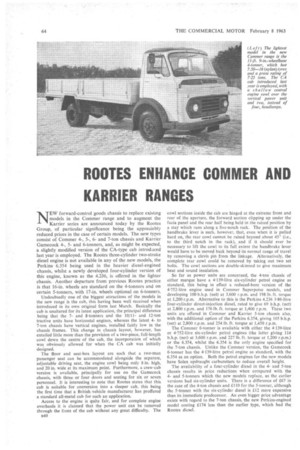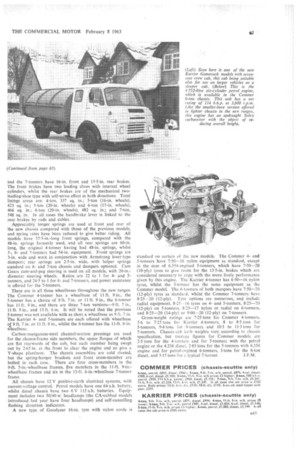ROOTES ENHANCE COMER AND KARRIER RANGES
Page 66

Page 67

Page 69

If you've noticed an error in this article please click here to report it so we can fix it.
NEW forward-control goods chassis to replace existing models in the Commer range and to augment the Karrier series are announced today by the Rootes Group, of particular significance being the appreciably reduced prices in the case of certain models. The new types consist of Commer 4-, 5-, 6and 7-ton chassis and Karrier Gamecock 4-, 5and 6-tonners, and, as might be expected, a slightly modified version of the CA-type cab introduced last year is employed. The Rootes three-cylinder two-stroke diesel engine is not available in any of the new models, the Perkins 6.354 being used in the heavier diesel-engined chassis, whilst a newly developed four-cylinder version of this engine, known as the 4.236, is offered in the lighter chassis. Another departure from previous Rootes practice is that 16-in, wheels are standard on the 4-tonners and on certain 5-tonners, with 17-in, wheels optional on 6-tonners.
Undoubtedly one of the biggest attractions of the models in the new range is the cab, this having been well received when introduced in its own original form last March. Basically the cab is unaltered for its latest application, the principal difference being that the 7and 8-tanners and the 10/11and 12-ton tractive units have horizontal engines, whereas the latest 4to 7-ton chassis have vertical engines, installed fairly low in the chassis frames. This change in chassis layout, however, has entailed little more than the provision of a two-piece, full-length cowl down the centre of the cab, the incorporation of which was obviously allowed for when the CA cab was initially designed.
The floor and seat-box layout are such that a two-man passenger seat can be accommodated alongside the separate, adjustable driving seat, the engine cowl being only 8 in. high, and 20 in. wide at its maximum point. Furthermore, a crew-cab version is available, principally for use on the Gamecock chassis, with three' or four doors and seating for six or seven personnel. It is interesting to note that Rootes states that this cab is suitable for conversion into a sleeper cab, this being the first time that a British,vehicle manufacturer has proffered a standard all-metal cab for such an application.
Access to the engine is quite fair, and for complete engine overhauls it is claimed that the power unit can be removed through the front of the cab without any great difficulty. The B40
cowl sections inside the cab are hinged at the extreme front and rear of the aperture, the forward section clipping up under the facia panel and the rear half being held in the raised position by a stay which runs along a five-notch rack. The position of the handbrake lever is such, however, that, even when it is pulled hard on, the rear cowl cannot be raised beyond about 45° (i.e., to the third notch in the rack),. and if it should ever be necessary to lift the cowl to its full extent the handbrake lever would have to be moved back beyond its normal range of travel by removing a clevis pin from the linkage. Alternatively, the complete rear cowl could be removed by taking out two set bolts. The cowl sections are double-skinned to give 'maximum heat and sound insulation.
So far as power units are concerned, the 4-ton chassis of either marque have a 4-139-litre six-cylinder petrol engine as standard, this being in effect a reduced-bore version of the 4-752-litre engine used in Commer Superpoise models, and developing 100 b.h.p. (net) at 3,600 r.p.m. and 198 lb. ft. torque at.1,200 r.p.m. Alternative to this is the Perkins 4.236 3-86-litre four-cylinder direct-injection diesel, rated to give 69 b.h.p.. (net) at 2,800 r.p.m. and 176 lb. ft. torque at 1,400 r.p.m. These two units are offered in Commer and Karrier 5-ton chassis also, with the additional option of the Perkins 6354, giving 105 b.h.p. (net) at 2,800 r.p.m. and 254 lb. ft. torque at 1,450 r.p.m.
The Commer 6-tonner is available with either the 4.139-litre or 4-752-litre six-cylinder petrol engines (the latter giving 114 b.h.p. (net) at 3,600 r.p.m. and 227 lb. ft. torque at 1,200 r.p.m.) or the 6.354, whilst the 6.354 is the only engine specified for the 7-ton chassis. Unlike the Commer version, the Gamecock 6-tonner has the 4.139-litre petrol engine as standard, with the 6.354 as an option. Both the petrol engines for the new models have Solex updraught carburetters to .reduce overall height
The availability of a four-cylinder diesel in the 4and 5-ton chassis results in price reductions when compared with the 4and 5-tonners which the new models replace, as the earlier versions had six-cylinder units. There is a difference of £67 in the case of the 4-ton chassis and £110 for the 5-tonner, although the 5-tanner with the six-cylinder diesel is £12 more expensive than its immediate predecessor. An even bigger price advantage exists with regard to the 7-ton chassis, the new Perkins-engined model costing £174 less than the earlier type, which had the Rootes diesel.
Two new gearboxes have been developed, one being a fourspeed constant-mesh unit with forward ratios of 4.96, 3.101, 1.662 and 1 to 1, and which is standard in the Commer 4-, Sand 6-tonners. Also new is a five-speed synchromesh box (which goes into production next month), this having forward ratios of 7.497, 3.983, 2-555, 1-590 and 1 to 1 and being offered as optional equipment in Cornmer 6and 7-tonners and the Karrier 6-tonner. The Rootes four-speed synchromesh gearbox which has been in use for several years is standard in the Commer 7-tonner and the Karrier 4-, 5and 6-ton chassis, and is optional in the Commer 5-tanner. All Karriers have hall-bearing clutch-release assemblies.
New hypoid-bevel rear axles are standard in 4-, 5and 6-ton chassis, whilst 7-ton mode's have a spiral-bevel unit. An Eaton 13802 two-speed axle is offered for 5-, 6and 7-tonners, and for tipper and other heavy-duty applications on the 7-tanner the Eaton 16802 axle is specified. Electric shifts are employed. There is a wide range of axle ratios, and in certain cases the standard ratios vary according to the type of engine and the size of wheel chosen. Typical maximum speeds with the standard axles are as follows: 4-ton, petrol, 64 m.p.h., diesel, 50 m.p.h; 5-ton, petrol. 56 m.p.h., four-cylinder diesel, 44 m.p.h., six-cylinder diesel. 58 m.p.h.; 6-ton, petrol, 57 m.p.h., diesel, 51 m.p.h.; and 7-ton, 52 m.p.h. Again with the standard gearing, bottom-gear gradient performances range between 1 in 4 and 1 in 5.
Girling hydraulic brakes, and Clayton Dewandre Hydrovac servos, are employed on all the new models, with Airpak air servos optional on 7-tonners. Vehicles with 16-in, wheels have 12-25-in.-diameter brakes at both axles, the 17-in.-wheeled 6-tanner has 13.5-in, brakes at both axles, identical units being employed on 5-tanners with 20-in, wheels, the 6-tonner with 20-in. equipment has 16-in, front and 15-25-in, rear brakes,
and the 7-tanners have 16-in, front and 15.5-in, rear brakes. The front brakes have two leading shoes with internal wheel cylinders, whilst the rear brakes are of the mechanical twoleading-shoe type with self-servo effect in both directions. Total linings areas are: 4-ton, 337 sq. in.; 5-ton (16-in. wheels), 423 sq. in.; 5-ton (20-in. wheels) and 6-ton (17-in. wheels),
466 sq. in.; 6-ton (20-in. wheels), 482 sq. in.; and 7-ton, 548 sq. in. In all cases the handbrake lever is linked to the rear brakes by rods and cables.
.Appreciably longer springs are used at front and rear of the new chassis compared with those of the previous models, and spring rates have been reduced to give better riding. All models have 57.5-in.-long front springs, compared with the 48-in, springs formerly used, and all rear springs are 60-in.
long, the original 4-tonner having had 48-in, springs, whilst 5-, 6and 7-tonners had 54-in. equipment Front springs are 3-in, wide and work in conjunction with Armstrong lever-type dampers; rear springs are 2-5-in, wide, with helper springs standard on 6and 7-ton chassis and dampers optional. Cam Gears cam-and-peg steering is used on all models, with 20-in diameter steering wheels. Ratios are 22 to 1 for 4and 5tonners, and 24.5 to 1 for 6and 7-tanners, and power assistance is offered for the 7-tonners.
There are in all three wheelbases throughout the new ranges. The Commer 4-tonner has a wheelbase of 11 ft. 9 in., the 5-tanner has a choice of 9 ft. 7 in. or 11 ft. 9 in., the 6-tonner has 11 ft. 9 in., and there are three 7-ton versions-9 ft. 7 in., 11 ft. 9 in., and 13 ft. 6 in. It will be noted that the previous 5-tonner was not available with as short a wheelbase as 9 ft, 7 in. The Karrier 4and 5-tonners are each offered with wheelbase of 9 ft. 7 in. or 11 ft. 9 in., whilst the 6-tonner has the 11-ft. 9-in. wheelbase.
Carbon-manganese-steel channel-section pressings are used for the chassis-frame side members, the upper flanges of which are flat rearwards of the cab, but each member being swept out by 2.65 in. at the front to clear the engine and so give a Y-shape planform. The chassis assemblies are cold riveted, but the spring-hanger brackets and front cross-member are bolted in each case. There are four cross-members in the 9-ft. 7-in.-wheelbase frames, five members in the 11-ft. 9-in.wheelbase frames and six in the 13-ft. 6-in.-wheelbase 7-tonncr frame.
All chassis have 12 V positive-earth electrical systems, with current-voltage control. Petrol models have one 64 a.h. battery, whilst diesel chassis have two 6 V 115 al'. batteries. Equipment includes two 5040 w headlamps (the CA-cabbed models introduced last year have four headlamps) and self-cancelling flashing direction indicators.
A new type of Goodyear 16-in. tyre with nylon cords is standard on certain of the new models. The Commer 4and 5-tonners have 7-50-16 nylon equipment as standard, except in the case of 6.354-engined 5-tanners, which have 7-50-20 (10-ply) tyres to give zoom for the 13-5-in, brakes which are considered necessary to cope with the more lively performance given by this engine. The Karrier 4-tonner has 6'50-16 nylon tyres, whilst the 5-tanner has the same equipment as the Commer model. The 6-tanners of both marques have 7-50-20 (12-ply) tyres as standard, whilst the Commer 74onners have 8.25-20 (12-ply). Tyre options are numerous, and include radial equipment, 8.25--16 tyres on 4and 5-tonners, 8-25-20 (12-ply) on 5-tonners, 8-25-17 nylon or radial on 6-tanners, and 8-25-20 (14-ply) or 9.00-20 (12-ply) on 7-tonners.
Gross-weight ratings are 7-25 tons for Commer 4-tanners, 5.6 to 7-25 tons for Karrier 4-tanners, 8 to 8-5 tons for 5-tanners, 9.4 tons for 6-tanners and 10-3 to 11-3 tons for 7-tonners. Chassis-cab kerb weights vary according to chassis specification, but average figures for Commer models are 2-5 tons for the 4-tanners and for 5-tonnera with the petrol engine or the 4.236 diesel, 2-85 tons for the 5-tanners with .6.354 engine and for petrol-engined 6-tonners, 3 tons for the 6-ton diesel. and 3.15 tons for a typical 7-tormer.




















































































































